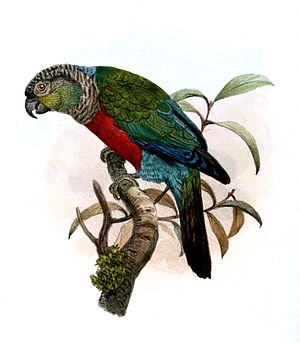Crimson-bellied parakeet
| Crimson-bellied conure | |
|---|---|

| |
| Scientific classification | |
| Kingdom: | Animalia |
| Phylum: | Chordata |
| Class: | Aves |
| Order: | Psittaciformes |
| Family: | Psittacidae |
| Genus: | Pyrrhura |
| Species: | P. perlata
|
| Binomial name | |
| Pyrrhura perlata (Spix, 1824)
| |

| |
| Synonyms | |
|
Pyrrhura rhodogaster | |
The crimson-bellied parakeet (Pyrrhura perlata), more commonly known as the crimson-bellied conure in aviculture, is a species of parrot in the family Psittacidae.
Taxonomy
Its taxonomic history is potentially confusing. It was formerly known as Pyrrhura rhodogaster, but following a review it was discovered that the type specimen for P. perlata, long believed to belong to the closely related pearly parakeet, actually was a juvenile crimson-bellied parakeet. Consequently, P. perlata was transferred to this species, while P. rhodogaster became a junior synonym.
Description
Pyrrhura perlata adults are partly green in colour. They have yellow/green cheeks, turning to blue on lower cheeks. The breast is brown with pale off-white and dark brown barring. Crimson-bellied parakeets have a blue collar around their hindnecks, varying with each bird. They have red bend of wing, lesser underwing coverts; blue thighs to tail coverts The tail is brown/red. Pyrrhura perlata has a brown/grey beak. Its eye ring are bare and white. Its eyes are dark brown. Crimson-bellied conures weigh about 85–94 g.[2]
Distribution and habitat
It is found in the south-central Amazon rainforest in Brazil and Bolivia. It remains locally fairly common, but is threatened by accelerating deforestation in its range and consequently considered to be least concern by the IUCN.[1]
Food and feeding
This species prefers dense vegetation from the secondary forests and forest margins.[3] Their diet consists primarily of fruits of Trema micrantha, various palms, Cecropia, and flowers like Bertholletia excelsa.[4][5]
References
Notes
- ^ a b BirdLife International (2022). "Pyrrhura perlata". IUCN Red List of Threatened Species. 2022: e.T22685812A209393280. Retrieved 27 July 2022.
- ^ "Crimson Bellied Conure". parrots.org. World Parrots Trust. Archived from the original on 2009-03-02. Retrieved 2008-10-24.
- ^ Collar, N., Boesman, P. and Sharpe, C.J. 2016. Crimson-bellied Parakeet (Pyrrhura perlata). In: del Hoyo, J., Elliott, A., Sargatal, J., Christie, D.A. & de Juana, E. (eds.). Handbook of the Birds of the World Alive. Lynx Edicions, Barcelona.
- ^ del Hoyo, J., Elliott, A., Sargatal, J. 1997. Handbook of the Birds of the World, vol. 4: Sandgrouse to Cuckoos. Lynx Edicions, Barcelona, Spain.
- ^ Low, Rosemary, 2013. Pyrrhura Parakeets (Conures): Aviculture, Natural History, Conservation. Insignis Publications. Print.
Sources
- Collar, N. J. (1997). "Crimson-bellied Parakeet (Pyrrhura perlata)". In del Hoyo, J.; Elliott, A.; Sargatal, J. (eds.). Volume 4. Sandgrouse to Cuckoos. Handbook of the Birds of the World. Barcelona: Lynx Edicions. p. 439. ISBN 84-87334-22-9.Error: "Q1030321" is not a valid Wikidata entity ID.
- Articles with short description
- Short description with empty Wikidata description
- IUCN Red List least concern species
- Articles with 'species' microformats
- Taxonbars desynced from Wikidata
- Taxonbar pages requiring a Wikidata item
- Taxonbars with invalid from parameters
- Taxonbars without secondary Wikidata taxon IDs
- Pyrrhura
- Birds of Brazil
- Birds of Bolivia
- Birds of the Amazon Basin
- Birds described in 1824
- Taxonomy articles created by Polbot
- All stub articles
- Parrot stubs



